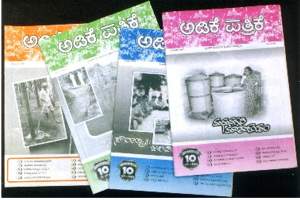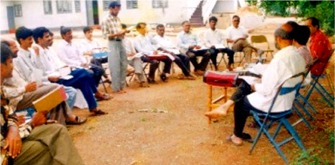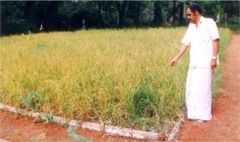Those who grow never write; those who write don't grow. This, in a nutshell, is the root problem of farm journalism. India has a good number of farm magazines, supplied at highly subsidized rates through subscription. Their aim: betterment of farming community. In numbers, they look impressive. But what about quality and purpose?
This article is about the details of a unique, successful experiment of self-help farm journalism, that is, farmers penning for their fellowmen. But before that it is essential to examine the deficiencies and drawbacks of the present kind of farm journalism.
Farm journalism is being fed mainly through two ways. One: through the magazines. Nine out of ten such magazines are either published by our agriculture universities or by the agriculture research institutes run by Indian Council of Agriculture Research. Two: through farm pages of mainstream dailies and periodicals. The commonality in both: the writers. Either they are scientists or professors of these institutions or so called agricultural experts. In one way or other all these writers are government controlled. These gentlemen write what they believe is useful for the farming community. But, in reality, for the target groups, it's nothing more than an academic output, which remains far off from their information needs.
Library-borne write-ups
Most of these write-ups are library-borne. Field contact is conspicuously lacking. That's why, a feature titled, 'Profitable crop: Turmeric' is almost a carbon copy of what has appeared a couple of years ago; except the long list of 4-5 writers attached to it. Old wine in old bottle. In the fields, cultivation methods differ from plot to plot; they don't remain stagnant for years. But even after a decade, our experts present the same old turmeric article as if it is new. Writers stick to a hackneyed formula. Take any crop, there are fixed sub-headings. Botanical description of the plant, required soil type, spacing, cultivation method, irrigation, manuring, diseases and pests, plant protection and economics. There is so much about the crop, but unfortunately, so little about the farmer.
What does the farmer have to say about this crop? What are its merits and demerits according to her/him? How does the method compare with older crops? Is there dependency for seed/planting material? Is this crop labor intensive? How easy or difficult the marketing is? Does it need profuse irrigation? How is the incidence of pest attack and diseases? Is pest/disease management difficult? How are the prospects of the crop assessed? Aren't these unanswered questions important from readers' point of view? Does your statistics of 'income per hectare' picked from research plots have any relevance for him?
Most of the articles recommend a heavy dose of chemical fertilizers and pesticides. Much against the ethics, many a times, brand names are also mentioned. This leaves a reader wondering whether the writer is doing a public relations exercise for some chemical company. Even if there are some proven non-chemical methods adopted by farmers, they are acknowledged, let alone being included.
Presentation of half-truths
Exaggeration and passing half-truths as reality is another serious problem. A farm journalist should have more responsibility and self-restraint before going into black and white. Thousands of farmers read an agricultural article, put lots of expenditure and pains to implement the recommended idea. The results are often not immediate, may be in a year, or even half a decade after. Whenever an article on a new crop or latest technology appears, it seldom makes any mention of the demerits. Only after years, when next crop is released or when improved version of this technology comes, the experts reveal the drawbacks of earlier crop/technology to emphasize that the newer is better. Farm writing of this sort misleads readers.
Furthermore, scientists are unable to communicate simply and effectively. But to be fair, during the course of their education, with the exception of extension staff, scientists are not trained for this. I am always of the opinion that the curriculum for agricultural scientists should include training to equip them with better and simple communication methods, and in local languages. Interaction with target groups of farmers then becomes less reliant on extension staff.

Being let down by the farm articles many a time, we, an apolitical farmers organisation, All India Areca Growers Association®, started a publication of our own called Adike Pathrike, over 12 years ago. Adike Pathrike was initiated as a monthly in Kannada mainly catering to areca growers. The uniqueness of the publication is that all major disciplines of a magazine production such as editing, publishing and even distribution (news agency) is mainly shouldered by practicing farmers, in addition to writing articles. This is an adventure which perhaps have no parallels in the country.
Adike Pathrike addresses the areca growers information needs. One advantage we have is that being farmers ourselves, we are in fairly better position to precisely list out our information needs and to divide it according priority. Our major challenge lies in identifying the writers who can deliver right kind of information, and then, to get it written by them.
The subjects we cover are of a very wide range. It's not about arecanut cultivation alone. Animal husbandry, dog rearing, poultry, research news, other crops like coconut, cocoa, banana, pepper, spices, vegetables, fruit varieties, farmer innovation, experiments, indigenous knowledge, herbal medicine, labor saving devices, farmers organizations, marketing achievements, organic farming, non-chemical pesticides, manure preparation, success stories, failure stories, post harvest technologies, driers, environment, rain harvesting, soil & water conservation (S&WC), forgotten agriculture practices -- the list is endless.
A meaningful platform
When we started, there was no such open platform for farmers. We thought that articles would pour in because we sincerely intended to highlight farmers' own time-tested experiences, That was not to be. What poured in were the same formula articles, which had a big name tag and very poor content. It didn't take us long to realize that to provide need-based information, you can't rely on write-ups that come on their own by mail. You have to slog to achieve quality.
We started appealing to farmers to send in any write-up, which they thought has a new and definite message for their counterparts. If need be, we'll rewrite it, we announced. This melted the ice, but not to the desired extent. One thing we were convinced was that if there is content in the output sent by somebody, style can be given. It didn't' matter if the situation required 2-3 rounds of correspondence or a few telephone calls. In the initial 5-6 years, more than 80 percent of farmers' inputs required subbing, rewriting or salvaging depending on the contents. But then, it is worth all the trouble taken.
Another realization that came is this: Unless the writer has a thorough knowledge of farming, or still better, experience in farming, it is very difficult to do justice. This is because a farm article calls for lot of practical ideas. It requires judgment, putting right questions to your source at right time, eliciting the information etc. Somebody has wisely said that only those who wear shoes can pinpoint where exactly it pinches!
Training farmers in journalism
Instead of pinning our hopes on staff journalists who didn't have time or inclination or both to pen down a worthy article for us, we wondered, why not impart a working knowledge of journalism to enthusiastic farmers? This is the objective with which we started our Krishikara Kaige Lekhani (meaning handing over pen to farmers, in Kannada) workshops. We gave wide publicity. Trainees were selected from among the applicants after screening.
Thus far we have conducted six four-day workshops in some selected rural hamlets covering 5 districts. One was organised in GKVK campus of University of Agriculture Sciences, Bangalore. Workshops covered lectures, exercises and a field assignment to identify issues and to elicit right kind of information from fellow farmers. Apart from 175 farmers, a sprinkling of agriculture officers from banks, professors from agricultural universities, a good number of agriculture graduates have been trained this way. The orientation is not only to write to our magazine, but to the mainstream media as well. Several writers have straddled the rungs of journalism and are today writing for even bigger publications.
The syllabus of the KKL workshops is brought out in a book form under the title Krishikara Kaige Lekhani. Today this has turned a reference guide to all the farm journalism workshops.
 A view of agricultural journalism workshop
A view of agricultural journalism workshop
Instead of 'producing' an issue from the voluntarily sent articles, we started identifying and commissioning farmers and others who had the stuff. If they were entirely new to writing, we would send a threadbare questionnaire. Answering all the questions almost provided the info you were looking for. If the writer was our trainee, some guidelines here and there would suffice. The lions share of our contents are exclusive and commissioned. If need be, we contact the commissioned farmer again and again by post or mail. On special situations either us or our trainees make a spot visit to help prepare a more reliable and objective article.
Identifying the information needs, searching for writer, contacting, encouraging him, follow-up - this is always an ongoing task. If you make a contact today, the article in its final shape might get ready after 6 months or one year. Our editor's job is not restricted to 'editing' only. He is more of a visualizer, an organizer, a guide and sometimes even a 'pesterer'!
Whenever we publish about a new crop, we juxtapose the introductory article with an opinion oriented one from an experienced farmer who has grown it for at least some years. The contact address and telephone number is also published. The idea is to provide the scope for an interested farmer reader to have a first-hand study and to come to his own conclusion.
Similarly in farmers' meets and seminars where we participate as co-organizers, we suggest inviting experienced farmers also as guests along with experts. There should be a mutually respecting relationship between the science and experience. It's high time to change the mental block that 'all experts are here to say and farmers to listen'.
A different information dynamic
The farmer is an unavoidable source of information because he is the real performer. Moreover, the question of credits, policy restrictions, institutional permissions and reputation and other issues does not come in his way of revealing the truth. The farmer calls a spade a spade. Even if some farmer tries to exaggerate or to plant stories with a vested interest, other farmers criticize this in the very next issue, though they might choose to ignore such misinformed writing by a scientist.
If a new crop grown by a farmer fails, s/he never conceals it. Most farmers are transparent in their views. If a newly wed bride asks with a mother of two as to how the delivery pain is like - the latter won't lie. Seeking an experienced farmer's views can be likened to this. For other farmer readers, a farmers direct views are always easy and helpful to arrive at their own opinion.
The approach of our agriculture extensions in Institutions/Universities does not take note of the wisdom, thinking capacity and intelligence of the receiver. Moreover, it's always one sided. A farmer's innovation or invention, however successful it is, not picked up by extension network for further spreading. Instead, it prefers to impose an unsuccessful one from a government research centre.
Self-help extension
Over a decade of observation, we found that for many of our farmers problems, their own counterparts have the right answer. Because of our poor farmer-to-farmer communication, this potential is not realized by the higher-ups and extension pundits. We, for example, have a monthly column called "Readers' Questions" in which farmers put many questions they are otherwise unable to answer. Some questions could even be silly sounding, but may be very important for their profession. Questions might range from how to control crab menace, to why coriander available in market doesn't germinate. Interestingly, other farmers come out with answers most of which are very useful. This column of Adike Pathrike is very popular.
An agricultural publication like many other profession-based journals has three possible expectations from its consumer. Buying, reading and most important - implementing. We get a feedback of considerable amount of implementation of practical ideas carried in our magazine. By way of diffusion, there are instances where it has extended to non-readers too.
Electronic fence to prevent cattle and wild boar, control of crabs, fruit-flies, rhinoceros beetles, vermicomposting on home and commercial scale, growing paddy on your threshing yard under rain fed conditions, 'ringing' method to induce yielding in citrus plants, pruning of mango trees for yielding, growing vegetables by double-digging method, top-working in jack & mango, emphasis on growing multiuse variety of forest spices like Kokum (Garcinia indica), Uppage (G.gummigutta), protecting areca gardens from northern sun-rays, recycling dried areca leaves etc in garden itself, fodder production for dairying, liquid slurry usage instead of buying manure from outside, sand bag check-dams, rain harvesting, and so on -- the list of widely adopted ideas is still big.
Creating awareness
By painstakingly collecting and disseminating information -- even through slide-shows and demonstrations -- we are able to build up considerable awareness in our circulation area of 8 districts - where water recharging was an unknown word earlier. For the past four years, we have been running a feature series in the subject. These are mostly success stories collected from different parts of the country. Taking clue from the series, quite a few people have implemented rain harvesting in their own way. Success stories have come from our readers themselves.
 Adike Pathrike published a feature on easier method of paddy cultivation based on a farmer's experience. Now this is practiced by many farmers in the region
Adike Pathrike published a feature on easier method of paddy cultivation based on a farmer's experience. Now this is practiced by many farmers in the region
Adike Pathrike has a column called seed distribution. Agricultural Universities and Research Stations release new plant varieties. But the interest with which they send the press releases for publication doesn't sustain; in the meantime, interested farmers approach them for some sample seeds. We tried to bridge this gap in a small way. We collecting information on newly released seeds from scientific institutions as well as on threatened varieties from farmers. A publication on the variety follows in the magazine. Seeds are then distributed by mail to those who send self-addressed envelopes and directly to farmers who visit our office for the purpose.
Widening the canvas
Later, we started two important columns: Plant Friendship and Farm Experience Exchange Tour. Like a pen friends column, readers with plant varieties and those interested in having some specific plants send their entries to the column. After publication, there will be mail and personal contacts, developing into friendship, courtesy a plant.
Imagine that a farmer wants to make a study about a particular crop or technology. It is no use directly visiting the place, staying in nearby lodge and then making inquires. Instead, if s/he directly visits a farmer of that area with prior consent, the visit would be more effective. This way farm information is exchanged between those interested to 'talk about it' and those who want to 'know further'.
Five years ago, we floated a unique plant friendship organization at Puttur called 'Samruddhi'. The objective is to exchange information and planting material between hobbyists of vegetable, fruit, ornamental and medicinal plant growers. About 40-50 farmers from the neighboring five taluks meet regularly in a month. Exchange takes place in the meeting and also personal contact between members. Newer varieties of plants, seeds etc are 'imported' from other parts of the country and are distributed. Study tours are frequently conducted. Variety consciousness has risen a great deal. For plant-lovers around, Samruddhi meeting is a much-awaited occasion now.
Over a decade of standing, Adike Pathrike has been successful in making a definite footprint in purposeful farm journalism. Many of the district newspapers reproduce articles from our magazine, mentioning the source. Mainstream press is now accommodating more agriculture articles. On invitation from Krishiloka, a Kannada farm monthly of 25 years, Ksheerasagara, a Kannada monthly on dairy farming by Karnataka Milk Federation (KMF) and the Kerala Horticulture Development Corporation (KHDC) which publishes a newsletter in Malayalam, the Adike Pathrike team has planned and conducted journalism workshops. Honeybee (English - Gujarat) and Iliea (English - Netherlands), Malayala Manorama (Malayalam - Kerala) and many Kannada periodicals have published features hailing the idea of farmer-to-farmer communication. An opinion poll conducted by us found this: most subscribers of Adike Pathrike don't put their old issues to 'raddi'; they are book bound and preserved for future reference.
Reliability, it seems, is our greatest achievement.























